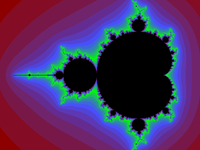Calculated image

A calculated image is the term used to describe images that are created by combining formal mathematics ( algebra , analysis ) and geometry . As a rule, such images are generated on the computer using certain algorithms . This can be either rasterized and processed on the basis of two-dimensional image descriptions or images rendered from a three-dimensional scene .
History and Development
The forerunners of the calculated images can be traced back to the beginning of modern times, when the linear perspective was discovered by Leon Battista Alberti and Filippo Brunelleschi .
The first pictures calculated in the narrower sense, however, come from the brothers Ernst Heinrich Weber and Wilhelm Eduard Weber in 1836 and were included in the book The Mechanics of Human Walking Tools. An anatomical-physiological study (Göttingen 1836) published; it is the graphic representation of the positions of the human gait in the various phases of movement. Differential equations were used to produce these phase images .
The invention of the phenakistiscope by Joseph Plateau and Simon Ritter von Stampfer made it possible to animate the drawn phase images . With the help of photography , Étienne-Jules Marey , Eadweard Muybridge and Ottomar Anschütz recorded similar movement studies in their momentary photographs from around the 1870s onwards , without these being calculated images.
The development of graphics-capable computers since the 1950s made a new dimension of the calculated images possible. The fractal geometry , founded by Benoît Mandelbrot around 1980, visualized mathematical equations. Other milestones of the calculated image were the development of raster graphics in the 1970s and various rendering methods such as ray tracing and radiosity ; see history of computer graphics .
Media-theoretical positioning
Calculated images occupy a special position in terms of media theory , as they can neither be assigned to the classical canon of art history , nor is there a suitable theory of image science .
Vilém Flusser provides the best explanatory models with his theory of technical images in the context of communication and media philosophy ; here all variants of the image are subsumed that arise through the application of mathematical formulas, including photography. This consideration extends the framework further than Friedrich Kittler , who limits the calculated images to the concrete and direct application of formulas such as differential equations; In the case of Flusser, on the other hand, technical images are created through devices or device-free applications that are made possible by formulas and equations.
A more recent term is "procedural animation" for moving image sequences that are generated by means of software, i.e. any type of 3D and 2D animation in which all or a large part of the movement phases are calculated.
See also
literature
- Friedrich Kittler: Writing and Numbers - The History of the Calculated Image . In: Christa Maar and Hubert Burda (eds.): Iconic Turn . DuMont, Cologne 2004, ISBN 3-8321-7873-2 .
- Werner Müller, Norbert Quien: Invented forms, calculated images. Germany's late Gothic spatial art in a new perspective . Vdg, Weimar 2000, ISBN 3-89739-108-2 .
Web links
- The Present Starry Sky (calculated images of the starry sky at a certain point in time at a certain place on earth by entering position according to longitude and latitude)
